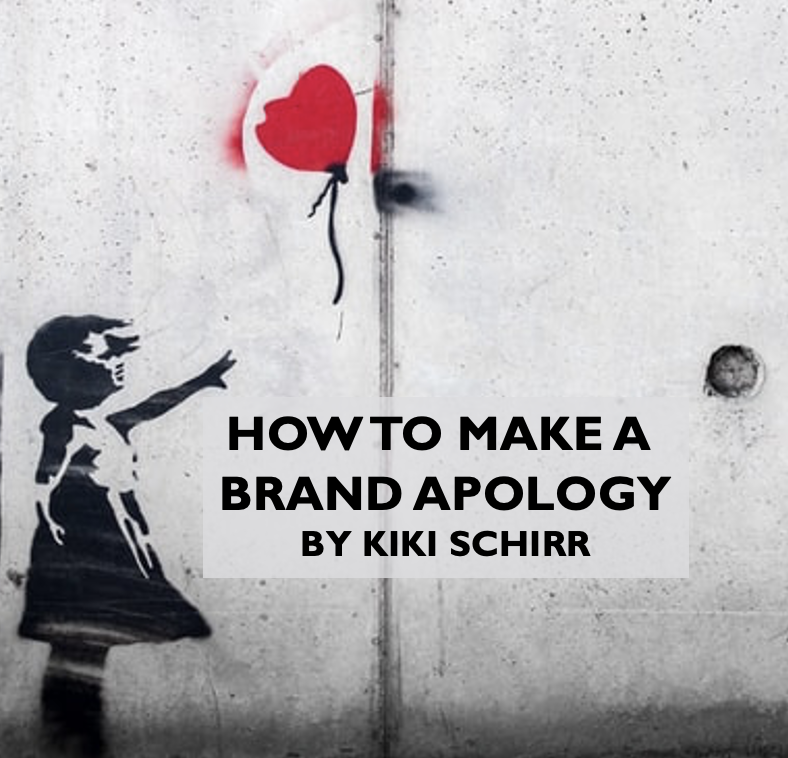
By Kiki Schirr, {grow} Contributing Columnist
We’ve all experienced bad apologies:
I’m sorry you feel that way.
(non-acknowledgment of wrongdoing that can even suggest the person is being too emotional)
I’m sorry you’re upset, but this isn’t my problem.
(passing the buck)
I’m sorry, but the situation was inevitable with the way you behaved.
(passing the buck back to the customer!)
The simplest way to improve your apologies is to avoid being awful! But how do we improve the official company apology from there?
If you’re running a small business, dealing with angry customers can feel overwhelming. You want to be professional but you probably don’t have your own legal team, PR team, crisis management team, and a host of others at your beck and call.
So how should a business approach apologies?
1) Basic steps of brand apologies
From personal experience and the wisdom of HBR, Adam Lazare, Contagious and other expert opinions, I think that there is a very rough outline for sincere brand apologies:
- Display empathy for the situation
- Agree the customer’s feelings are reasonable given their experience
- Acknowledge your part in the situation
- Try to find a solution that satisfies the customer
- Show that you will change your policy in the future
Of course, it will require tweaking to fit your exact situation and there might be additional steps in the event of a major mistake, but most good apologies follow that outline.
Today I’m going to give you some advanced techniques to nail your brand apologies:
2) Never erase, only replace
If you’ve put out false information or offended with written content, don’t delete all traces of it in a panic.
In 2015, Mark Schaefer made a mistake (it is whispered in marketing channels that this was the first and only time) and he then wrote an excellent digital apology for misrepresenting some of the features of a marketing tool. It was an honest mistake but Mark didn’t shy away from addressing it.
I’m showing this example because he did something very clever in this post that I haven’t seen used widely. Mark didn’t erase the errant post — he replaced it:

If you panic and delete a problem post, when visitors return (possibly with outraged friends in tow), they’ll only find a 404 error without any explanation. Many people, especially when they’re already angry, will see this as suspicious behavior. Maybe you’re just “covering your tracks.”
Use Mark’s innovation: he wrote over the initial post, fully acknowledging why he had replaced the erroneous content. This allowed him to end the confusion without a dead link. By posting his apology on the same initial link, everyone who had seen the incorrect information saw the very professional retraction.
3) Create a crisis response playbook
If the customer service person on duty isn’t authorized to make major decisions (a questionable but common practice) it can be tempting to tell them to “stall” until you can get in touch with lawyers — after all, sometimes an apology is cited as an admission of guilt.
Ideally, you should set standards for brand apologies through a social media policy before you or your team has time to form bad habits. It’s never too late to create a crisis response playbook.
Thinking through scenarios and proper responses will take time. If you’re in a field where you often need a legal team —healthcare, supplements, children’s toys, weight loss — you’ll definitely want to include your legal team. Draft a list of problems you’ve had in the past, and look for issues your competitors have faced — especially apology fails. If you take the high road where you’re competitor is known to go low, you might win loyal customers.
You’ll need to tailor these suggestions to your own industry, but here are a few things you might want to add:
- If the customer suggests your product has become a safety issue, escalate immediately.
- If that safety issue could be fatal, call the CEO’s cell phone number, regardless of the hour. Have your legal team ready.
- If the customer’s post is gaining traction and wide sympathy, escalate immediately.
- If the customer complaining is a celebrity or a respected member of your core community, either escalate or call the CEO as the employee feels necessary
4) The toughest brand apologies
How do you handle brand apologies when accusations are false or self-serving?
You might want to set a dollar amount max for product replacement or other customer appeasement methods in situations where verification is an issue. Or like many tech company policies on children downloading products with their parent’s credit card, you get one refund, no matter how major, no questions asked. But that’s the only time you’ll help without proof.
How do you handle customers that want to draw attention to your discussion and refuse to enter a private channel?
You’ll want to handle the apology in a manner consistent with your brand’s voice and customer base. The way Neiman Marcus apologizes is very different from the apology that PewDiePie’s fans want.
What if you’re not the party at fault? What if it was chance? What if it was someone else’s fault?
Don’t point fingers or use the name of the brand or person you suspect screwed it up. Outline the things you’re in control of and the things that are results of chance. Acknowledge that the trouble is still annoying, no matter who is at fault. Offer to work with them to find a solution.
How do you handle accusations that your company is racist/homophobic/misogynist or other reasons your service failure might have been a form of bigotry?
This can be a nightmare scenario. First, what not to do:
Don’t question whether the form of discrimination they’re citing is actually real. Another typical cringe-worthy error is to assert that you can’t be _____ist because you have ____ friends.
Best practices include:
- Investigate the issue
- Ask how you can make it better for them in this instance
- Ask whether they have any suggestions for the future (but don’t require that they solve future problems for you)
- State that you had no ill intent
- Avoid widening the perceived gap between your brand and the individual by using “we” about the brand vs. “you” to mean people like them.
- Mirror their language and use their terminology to describe the situation you want to avoid happening again in the future
- Address and fix the core issue before defending your brand
While you might feel defensive about your brand being accused of discrimination, you should try to quash the fear of others believing the accusations long enough to fix the actual problem.
When the problem is fixed, then analyze the situation and what your company did or didn’t do wrong. Is there something you should change going forward?
It is also possible that you did nothing wrong, but either way, you should treat your customer with respect. Keep your cool and remind yourself that you can’t know what is happening in their life.
You will likely have many silent eyes watching brand apologies like this, so try to make it right in a manner that feels compassionate, honorable, and on-brand for your company’s values.
5) Just be human
Ultimately, the best way to humanize your brand is to face each interaction as if you are dealing with your neighbor, face-to-face.
Just be human back.
 Kiki Schirr is a freelance marketer, writer, and former founder who enjoys new technologies. She believes success is a product of luck, tenacity, and chutzpah. You can email Kiki Schirr at her full name without spaces at Gmail. Just remember that she responds faster on Twitter.
Kiki Schirr is a freelance marketer, writer, and former founder who enjoys new technologies. She believes success is a product of luck, tenacity, and chutzpah. You can email Kiki Schirr at her full name without spaces at Gmail. Just remember that she responds faster on Twitter.


